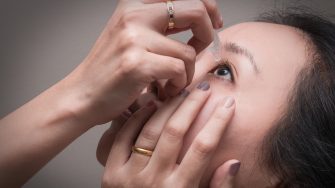
Dry eye disease occurs when your tears aren’t able to provide enough lubrication for your eyes. There are many reasons for this tear film dysfunction including hormone changes, allergies, and autoimmune disease. Treatment aims to restore or maintain the normal amount of tears in the eye to minimise discomfort and maintain eye health. View our current studies into dry eyes.
-
The research study is looking to recruit people who meet the following criteria:
- Participants with the age of ≥18 years
- Have symptoms and signs of dry eye disease
- Willing to use commercially available artificial tear supplements.
-
You are a potential participant for the study if:
- You are above 18 years of age.
- You do not wear contact lenses on the day of the visits.
- You are non-contact lens wearers OR soft contact lens wearers of at least 5 hours wear for at least 5 days a week.
- You are not current or previous wearers of hard contact lenses, including Ortho-K lenses.
- You can participate in this clinical experiment (about one hour, one visit ) by the beginning of March.
-
We are looking recruit people who meet the following inclusion criteria:
- Age 18 years or over.
- Be able to read and comprehend English and provide informed consent.
- Have either healthy meibomian glands or meibomian gland dysfunction.
- Be able to attend UNSW School of Optometry and Vision Science clinic in person.
Participants meeting the following criteria will be excluded from the study:
- Any active anterior eye disease.
- History of eye trauma or surgery (including corneal refractive surgery) in the previous 12 months.
- Any systemic disease that may affect ocular surface health, e.g., Graves' disease, and auto-immune diseases such as spondylitis, multiple sclerosis, and systemic lupus erythematosus.
- Recent use of systemic and/or topical antibiotics.
- Current use of anti-inflammatory drugs and immunosuppressive agents.
- Recent use of topical glaucoma medications and over-the-counter eye drops containing preservatives.
- Contact lenses in the past 3 months.
- Pregnancy.
- Known allergies to diagnostic stains, specifically fluorescein and lissamine green.
- Known allergies to topical anesthetic eye drops.
-
You are a potential participant for the study if
- You are above 18 years of age
- You have signs and symptoms of or have already been diagnosed with dry eye disease
You are not eligible to participate in the study if you meet any of the following conditions.
- You are currently using or have used any anti-inflammatory eye drops in the past 6 months
- You are on oral ciclosporin or tacrolimus
- You have known allergy to the study medication
- You have an active eye disease inside the eye
- You are a regular contact lens user or have used contact lenses in the last 4 weeks
- You have an active eye infection or critical illness
- You have dry eyes due to Steven-Johnson syndrome, cicatricial conjunctival disease
- You have other eye conditions or use eyedrops for glaucoma
- You have a history of eye surgery in the past 6 months
- You are pregnant or breastfeeding
-
You are a potential participant for the study if
- You are above 18 years of age.
- You have signs and symptoms or being diagnosed with dry eyes.
- If you are on systemic anti-inflammatory therapy such as steroids, Immunosuppressants you must not have changed the medications in the past 3 months.
- Your systemic disease activity is under control since the past 3 months.
- You don’t have any other ocular pathology other than dry eye disease.
-
Would the research study be a good fit for me?
The study might be a good fit for you if:
- Are aged over 18 years
- Currently have been diagnosed with immune disease-related dry eye.
- Have no previous probiotic or prebiotic commercial supplement intake in the last three months
- Are willing to provide written informed consent and willing to comply with consuming the probiotic and prebiotic products and adhering to the clinical trial visit schedule
